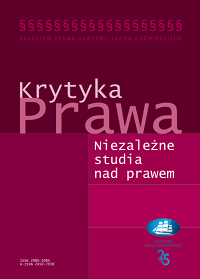100 lat państwowości czechosłowackiej i polskiej. Podobieństwa i różnice
100 Years of Statehood of Czechoslovakia and Poland. Similarities and Differences
Author(s): Maria KrukSubject(s): Political history, Social history
Published by: Akademia Leona Koźmińskiego
Keywords: constitutionalism; Velvet Revolution; transformations
Summary/Abstract: 100 years of constitutionalism of two neighbouring European states – Czechoslovakia, later becoming the Czech Republic, and Poland – encourage a reflection on the paths of development of their respective constitutions, on the historical stages and successive political transformations, not just in the context of individual constitutionalisms of each of those states but with an emphasis on the similarities and differences in this domain. And this is what this study focuses on. Starting from the common fate of rebirth of both states after WWI through the inter-war efforts to establish democratic constitutional systems and the obstacles found on the way, followed by the post-WWII period of real socialism ending with the era of transformations and stabilisation as democratic states of law. The text explores all the similarities found in both general aspects – like the references to the European tradition of parliamentary governance – and in certain specific solutions – like the differences in the concept of the two-chamber parliament. But there are also situations occurring in only one of the states, e.g. the federalisation of Czechoslovakia, the emergence of two separate states of the Czechs and Slovaks, or the differences in the course and sequence of events of democratic transformations in each of the states in the 1980s (martial law in Poland and the Velvet Revolution in Czechoslovakia), which brings us to the conclusion that despite all the possible differences, the two constitutional systems have actually been very similar to each other.
Journal: Krytyka Prawa
- Issue Year: 11/2019
- Issue No: 1
- Page Range: 33-34
- Page Count: 2
- Language: Polish

